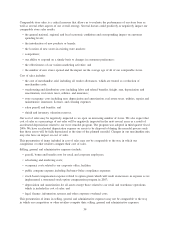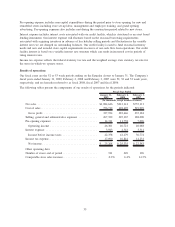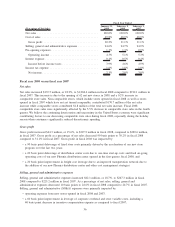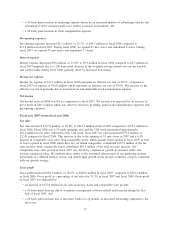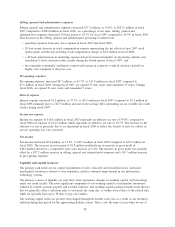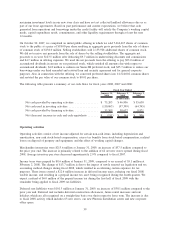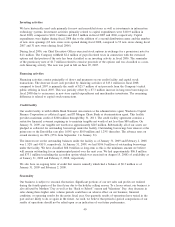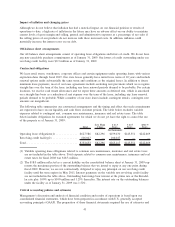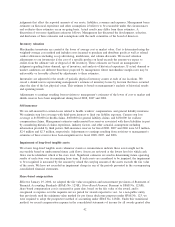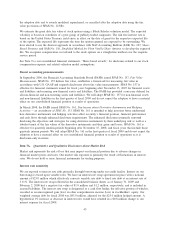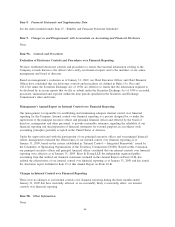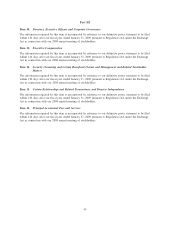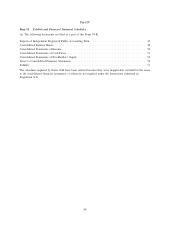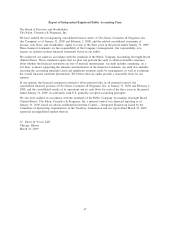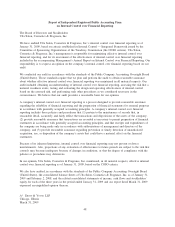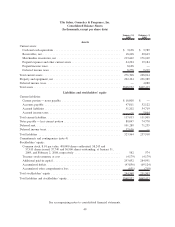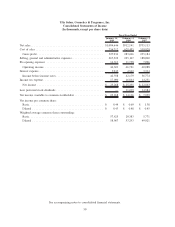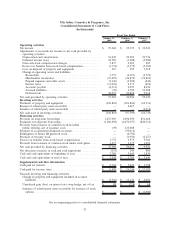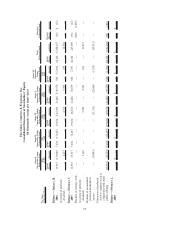Ulta 2008 Annual Report Download - page 49
Download and view the complete annual report
Please find page 49 of the 2008 Ulta annual report below. You can navigate through the pages in the report by either clicking on the pages listed below, or by using the keyword search tool below to find specific information within the annual report.the adoption date and to awards modified, repurchased, or cancelled after the adoption date using the fair
value provisions of SFAS No. 123(R).
We estimate the grant date fair value of stock options using a Black-Scholes valuation model. The expected
volatility is based on volatilities of a peer group of publicly-traded companies. The risk free interest rate is
based on the United States Treasury yield curve in effect on the date of grant for the respective expected life
of the option. The expected life represents the time the options granted are expected to be outstanding. We
have elected to use the shortcut approach in accordance with Staff Accounting Bulletin (SAB) No. 107, Share-
Based Payment, and SAB No. 110, Simplified Method for Plain Vanilla Share Options, to develop the expected
life. We recognize compensation cost related to the stock options on a straight-line method over the requisite
service period.
See Note 9 to our consolidated financial statements, “Share-based awards,” for disclosure related to our stock
compensation expense and related valuation model assumptions.
Recent accounting pronouncements
In September 2006, the Financial Accounting Standards Board (FASB) issued SFAS No. 157, Fair Value
Measurements. SFAS No. 157 defines fair value, establishes a framework for measuring fair value in
accordance with U.S. GAAP and expands disclosures about fair value measurements. SFAS No. 157 is
effective for financial statements issued for fiscal years beginning after November 15, 2007 for financial assets
and liabilities and recurring non-financial assets and liabilities. The FASB has provided a one year deferral for
all non-financial and non-recurring assets and liabilities. We will adopt SFAS No. 157 for non-financial assets
and non-financial liabilities in the first quarter of fiscal 2009 and do not expect the adoption to have a material
effect on our consolidated financial position or results of operations.
In March 2008, the FASB issued SFAS No. 161, Disclosures about Derivative Instruments and Hedging
Activities — an amendment of SFAS No. 133. SFAS No. 161 is intended to help investors better understand
how derivative instruments and hedging activities affect an entity’s financial position, financial performance
and cash flows through enhanced disclosure requirements. The enhanced disclosures primarily surround
disclosing the objectives and strategies for using derivative instruments by their underlying risk as well as a
tabular format of the fair values of the derivative instruments and their gains and losses. SFAS No. 161 is
effective for quarterly interim periods beginning after November 15, 2008, and fiscal years that include those
quarterly interim periods. We will adopt SFAS No. 161 in the first quarter of fiscal 2009 and do not expect the
adoption to have a material effect on our consolidated financial position or results of operations as it is
disclosure-only in nature.
Item 7A. Quantitative and Qualitative Disclosures about Market Risk
Market risk represents the risk of loss that may impact our financial position due to adverse changes in
financial market prices and rates. Our market risk exposure is primarily the result of fluctuations in interest
rates. We do not hold or issue financial instruments for trading purposes.
Interest rate sensitivity
We are exposed to interest rate risks primarily through borrowing under our credit facility. Interest on our
borrowings is based upon variable rates. We have an interest rate swap agreement in place with a notional
amount of $25.0 million which effectively converts variable rate debt to fixed rate debt at an interest rate of
5.11%. The interest rate swap reflected in the consolidated balance sheets as of January 31, 2009 and
February 2, 2008 had a negative fair value of $1.0 million and $1.2 million, respectively, and is included in
accrued liabilities. The interest rate swap is designated as a cash flow hedge, the effective portion of which is
recorded as an unrecognized gain (loss) in other comprehensive income (loss) in stockholders’ equity. Our
weighted average debt for fiscal 2008 was $83.0 million, adjusted for the $25.0 million hedged amount. A
hypothetical 1% increase or decrease in interest rates would have resulted in a $0.8 million change to our
interest expense for fiscal 2008.
43



